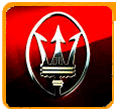1957 Maserati - next ››
The four Maserati brothers, Alfieri, Ettore, Ernesto and Bindo
Maserati, founded the company in Bologna in 1914. The first
car they built together was the Tipo 26, named after the year
it was built. Maserati quickly gained a reputation in racing
circles for developing fast cars, winning many race events.
Tipo 26
Launched in 1967, with a 4.7 V-8, 330 bhp, 4-cam-engine, the
Ghibli was no slouch, a 150mph supercar, even though no efforts
were made to keep weight down. Maserati decided on an all steel
body.
In later cars a 4.9 litre engine was fitted, this raised the
top speed to 165mph, even though the new engine produced a modest
increase in power, just 4bhp. This increase in speed was due
to the engines magnificent torque.
The problem faced by Maserati when marketing the Ghibli (bottom
photo) was not the car itself, but the opposition. It appeared
at almost the same time as the Lamborghini Miura, and Ferrari’s
Daytona.
1972 Maserati Ghibli Spider
Giorgio Giugiaro called 1966 his best year of design. The Turnin
Italy Auto Show, where 4 of his most outstanding creations were
premiered, included one of his proudest, the Maserati Ghibli
Spider. With a noble lineage, those previewing its V-8 quad
CAM motor and legendary suspension knew it was a direct descendent
of the 50's Maserati competition cars. This car boasted an impressive
top speed of 168 MPH with its 5-speed transmission and 4.72
liter, 330 HP V-8. Just 1,274 Ghibli Spiders and Coupes were
built from 1966-1973.
Throughout the Thirties, Maserati continued making spark plugs
and hand-built sports and racing cars. They were unable to achieve
consistent success on the track, however. To some extent this
was because they were unable to generate the necessary investment
capital to stay seriously competitive and to protect their place
in the front rank: this is a problem for small racing car manufacturers
that has existed for very nearly a hundred years. From the racing
cars, a limited number of road cars were built, fitted with
coach built bodies. The 4CS-1100 and the 4CS-1500 were available
in 1932 and 1933
In March of 1932 , Alfieri died, as a result of an operation
on old injuries sustained in a racing accident some years previously.
Ettore, Bindo and Ernesto carried on to produce the three liter
8CM 150 mph Grand Prix car. Financially, things continued to
be relatively hard going, so the arrival on the scene of Commendatore
Adolfo Orsi in 1937 was very welcome. Orsi ran an industrial
combine that was involved in making machine tools and bus and
railway systems, although the connection with Maserati may well
have come about because the Orsi organization made spark plugs
– as did Maserati themselves.
The Maserati brothers were bought out and signed up for a ten
year consultancy deal, relieving them of direct money problems,
thus enabling them to concentrate on making racing cars and
the occasional spin-off road car. During this period, the A6GCS
car was conceived and constructed, and the 2-litre Formula 2
car was designed and built, and that in turn developed and evolved
into the legendary 250F (2493cc straight six, 270bhp, top speed
180mph). The gearbox was rear-mounted in a transaxle unit behind
the seat: it was a four-speed unit at first, and later improvements
included a fifth gear. The later cars also benefited from a
redesigned and considerably lighter chassis.
With Juan Manuel Fangio in the driving seat, this beautiful
and seriously quick Maserati won the World Championship in 1957:
one of the high points for the Maserati company. As well as
the racing cars, chassis were being shipped off to various coachbuilders
for a variety of bodywork to be fitted: PininFarina, Vignale
and Frua all made their own contribution with an assortment
of sports and sports racing bodies
When their ten year consultancy contract expired, the remaining
Maserati brothers couldn't resist the pull of freedom and independence,
and went off on their own to form OSCA – Officine Specializzata
Costruizone Automobili. The Maserati name stayed with the Orsi
family. The 1600 Osca was a neat and attractive little car,
resembling its bigger Maserati brothers in the elegance of its
proportions on rather a smaller scale, and powered by a double
overhead camshaft four-cylinder engine, with two huge Webers
squeezed into the diminutive engine bay. The interior was typically
Italian of the period: two big dials for speed and revs, a thin
woodrim wheel and sparse interior comforts: after all, it was
for going quickly rather than being cosseted in Grand Tourer
style. Badgework on the car was limited to OSCA 1600 on the
bootlid, Fissore Savigliano on the front wings and a round badge
on the front bearing the O.S.C.A. legend and a coat of arms,
with 'Fratelli Maserati Bologna' running around the outside
indicating that, although it wasn't a Maserati as such, it had
certainly been built by the Maserati brothers. |




